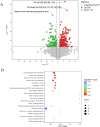Dietary wet fermented Brewer's grains modulate hepatic metabolism in pullets
- PMID: 40379717
- PMCID: PMC12084578
- DOI: 10.1038/s41598-025-01743-3
Dietary wet fermented Brewer's grains modulate hepatic metabolism in pullets
Abstract
This study was conducted to evaluate the effects of wet-fermented brewer's grains (WFBG) on liver metabolism in pullets. A total of 120 female 84-d-old pullets (575.2 ± 4.3 g) were randomly allocated into 2 treatments (0% and 20% WFBG) with 6 replicates per group and 10 birds per replicate in this 28-d experiment. Birds fed 20% WFBG had higher (P < 0.05) superoxide dismutase (SOD) level and lower (P < 0.05) malondialdehyde (MDA) content in the liver compared with the control group. In total, 324 liver differentially-expressed metabolites (DEMs) including 208 up-regulated DEMs and 116 down-regulated DEMs were identified and considered to be related with WFBG. Pathway analysis revealed that these DEMs were mainly involved in 64 metabolic pathways including metabolic pathways metabolism, glycerophospholipid (GP) metabolism, linoleic acid (LA) metabolism, arachidonic acid metabolism (ARA), and alpha-linolenic acid metabolism. Furthermore, untargeted metabolomic analyses uncovered 18 common up-regulated DEMs and 8 common down-regulated DEMs in GP, LA and ARA metabolism in the 20% WFBG group (P < 0.05), such as lysophosphatidylcholine (LPC(18:0/0:0), LPC(0:0/20:4)), lysophosphatidylethanolamine (LPE(22:6/0:0)), and 1-palmitoyl-2-oleoyl-sn-glycero-3-phosphocholine. Overall, the inclusion of 20% WFBG in the diets of pullets led to alterations in liver metabolism.
Keywords: Liver health; Metabolomics; Pullet; Wet-fermented Brewer’s grains.
© 2025. The Author(s).
Conflict of interest statement
Declarations. Competing interests: The authors declare no competing interests.
Figures





Similar articles
-
Effects of graded levels of microbial fermented or enzymatically treated dried brewer's grains on growth, digestive and nutrient transporter genes expression and cost effectiveness in broiler chickens.BMC Vet Res. 2020 Nov 5;16(1):424. doi: 10.1186/s12917-020-02603-0. BMC Vet Res. 2020. PMID: 33153443 Free PMC article.
-
Dietary yeast hydrolysate and brewer's yeast supplementation could enhance growth performance, innate immunity capacity and ammonia nitrogen stress resistance ability of Pacific white shrimp (Litopenaeus vannamei).Fish Shellfish Immunol. 2018 Nov;82:121-129. doi: 10.1016/j.fsi.2018.08.020. Epub 2018 Aug 10. Fish Shellfish Immunol. 2018. PMID: 30099143
-
Evaluation of corn fermented protein on the fecal microbiome of cats.J Anim Sci. 2024 Jan 3;102:skae268. doi: 10.1093/jas/skae268. J Anim Sci. 2024. PMID: 39276154 Free PMC article.
-
Influence of the particle size and form of feed on growth performance, digestive tract traits and nutrient digestibility of white egg-laying pullets from 1 to 112 D of age.Poult Sci. 2019 Sep 1;98(9):4016-4029. doi: 10.3382/ps/pez144. Poult Sci. 2019. PMID: 30953064
-
Effects of dietary ratio of linoleic to linolenic acid on performance, antibody production, and in vitro lymphocyte proliferation in two strains of leghorn pullet chicks.Poult Sci. 2005 Jun;84(6):846-57. doi: 10.1093/ps/84.6.846. Poult Sci. 2005. PMID: 15971520
References
-
- Vlaicu, P. A., Untea, A. E., Varzaru, I., Saracila, M. & Oancea, A. G. Designing nutrition for health-incorporating dietary by-products into poultry feeds to create functional foods with insights into health benefits, risks, bioactive compounds, food component functionality and safety regulations. Foods12 (21), 4001. 10.3390/foods12214001 (2023). - PMC - PubMed
-
- Eliopoulos, C., Arapoglou, D., Chorianopoulos, N., Markou, G., Haroutounian, S. A. & Conversion of brewers’ spent grain into proteinaceous animal feed using solid state fermentation. Environ. Sci. Pollut Res.29 (20), 29562–29569. 10.1007/s11356-021-15495-w (2022). - PubMed
-
- Deltoro López, J., Fernandez Carmona, J. & Martinez Pascual, J. L. Evaluation of Brewer’s dried grains in the diets of laying hens. Anim. Feed Sci. Technol.6 (2), 169–178 (1981).
-
- Pfaff, W. K., Moreng, R. E. & Kienholz, E. W. The utilization of brewers’ dried grains in the diets of Chinese ringneck pheasant-breeder hens. Poult. Sci.69 (9), 1491–1495. 10.3382/ps.0691491 (1990). - PubMed
-
- Pires Filho, I. C. et al. Effects of feeding dried Brewer’s grains to slow-growing broiler chickens. Live Sci.250, 104561. 10.1016/j.livsci.2021.104561 (2021).
MeSH terms
Substances
Grants and funding
LinkOut - more resources
Full Text Sources

